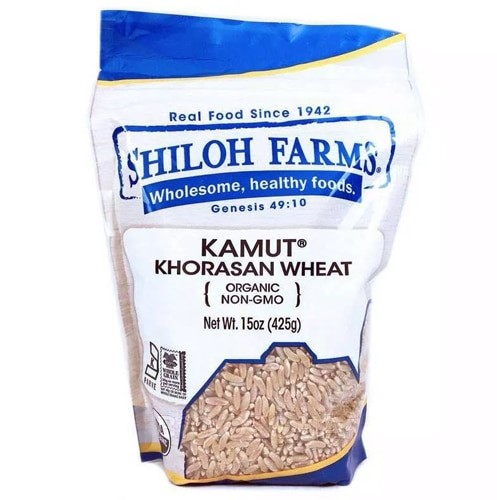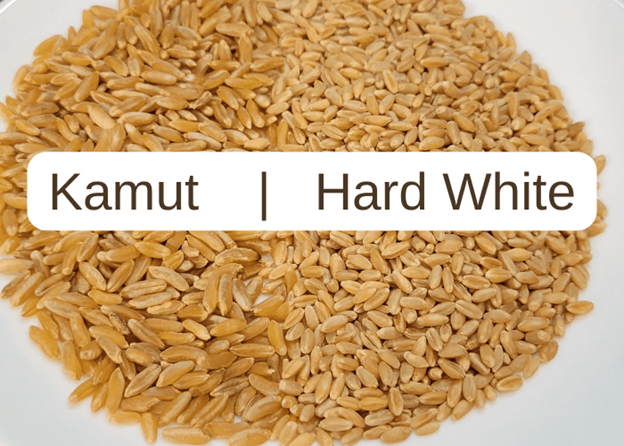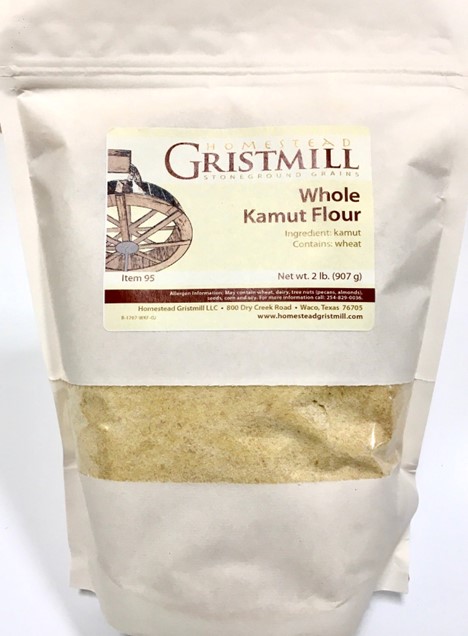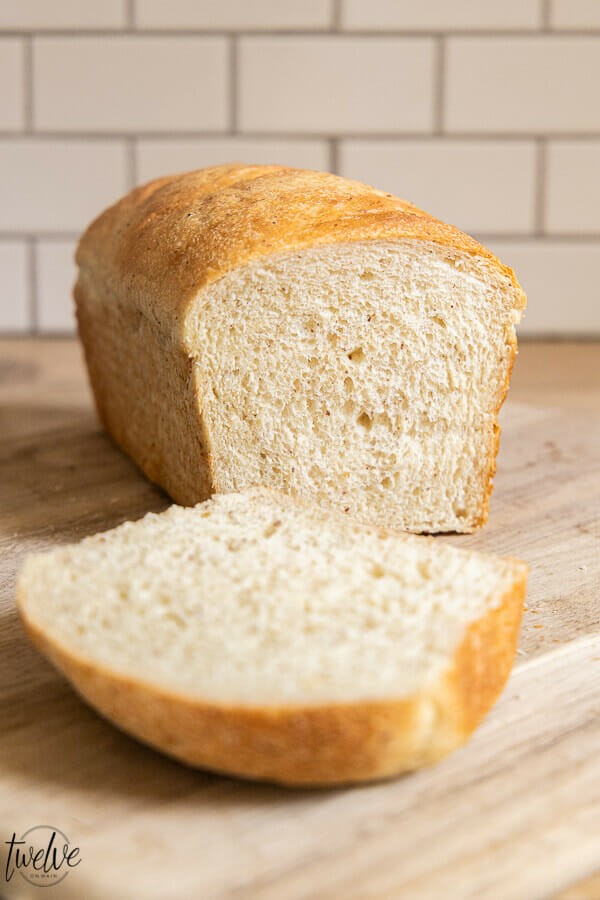What’s the Big Deal with KAMUT?
All you whole grain bakers out there, this is for you! If you’re interested in upping the nutrition in your baked goods, then you need to know about this variety of wheat. It’s a big deal.
I’m talking about Kamut. “Kamut” is a registered trademark for a variety of Khorasan wheat, an ancient grain believed to have originated in the Fertile Crescent region of Iran. The grain was first cultivated in America in the late 1970s, when two farming brothers began growing it. Today, it is only produced in the United States and Western Canada, and the Kamut brand has strict standards for any product bearing its name.

This is a grain guaranteed to never be hybridized or genetically modified. It is always organically grown and is known for its extremely diverse profile of polyphenols. Polyphenols are a family of molecules that have gained much attention as they have strong antioxidant and anti-inflammatory properties and can protect against many degenerative diseases.
Compared to regular wheat, Kamut has a significantly higher protein content (up to 40% more), more amino acids (up to 65% more). It contains copper, manganese, and molybdenum. And it’s also richer in vitamins E and B1 (thiamin) and niacin, potassium, magnesium, selenium, zinc, and phosphorous.

Because it’s an excellent source of phosphorus, Kamut is especially good for kidney function. Kamut’s good phosphorus content helps the body detox by eliminating toxins and waste through urine.
Kamut is extremely high in fiber, which is good for healthy digestion. It is also easier to digest than other whole wheat. This is because it has a different gluten content than whole wheat. Kamut is not gluten-free, but it is easier to digest than regular whole wheat for people who have gluten intolerance.
And something else: Kamut grain has been shown in recent studies to lower blood sugar levels. The glycemic index (GI) of Kamut flour equals to 45, which classifies it as a low GI food. It’s no small thing to find a whole grain flour that doesn’t spike blood sugar!

An exceptionally versatile flour, Kamut is most used for breads, breakfast cereals, waffles, pancakes, cookies, and pastas. It’s used in the same manner as wheat flour, and is known for yielding moist baked goods with a buttery flavor and a smooth texture. It has a yellowish color quite distinct from the usual brown color of whole wheat flour. If you research this flour, you’ll consistently read the word “amazing” in articles and reviews.
Kamut can be substituted for wheat flour in nearly equal proportion—7/8 cup of Kamut flour replaces 1 cup of wheat flour. Interested in doing a little substitution yourself? Here’s a great recipe to get your started. This is from Sara, of www.twelveonmain.com. She says it’s “…an easy and amazing bread using Kamut flour. It has a nutty and buttery flavor and texture that you won’t be able to get enough of.”

3 cups warm water (110-115 degrees)
1 1/2 tablespoons SAF Instant yeast
1/4 cup pure raw honey
4 to 5 cups Kamut flour
1/4 cup ground flaxseed
1 tablespoon salt
3 tablespoons dough enhancer (Vital Wheat Gluten®, optional and not necessary)
1/3 cup extra virgin olive oil
butter (optional for the top of the loaves)
Directions:
Add Recipe to Cook'n
I’m talking about Kamut. “Kamut” is a registered trademark for a variety of Khorasan wheat, an ancient grain believed to have originated in the Fertile Crescent region of Iran. The grain was first cultivated in America in the late 1970s, when two farming brothers began growing it. Today, it is only produced in the United States and Western Canada, and the Kamut brand has strict standards for any product bearing its name.

This is a grain guaranteed to never be hybridized or genetically modified. It is always organically grown and is known for its extremely diverse profile of polyphenols. Polyphenols are a family of molecules that have gained much attention as they have strong antioxidant and anti-inflammatory properties and can protect against many degenerative diseases.
Compared to regular wheat, Kamut has a significantly higher protein content (up to 40% more), more amino acids (up to 65% more). It contains copper, manganese, and molybdenum. And it’s also richer in vitamins E and B1 (thiamin) and niacin, potassium, magnesium, selenium, zinc, and phosphorous.

Because it’s an excellent source of phosphorus, Kamut is especially good for kidney function. Kamut’s good phosphorus content helps the body detox by eliminating toxins and waste through urine.
Kamut is extremely high in fiber, which is good for healthy digestion. It is also easier to digest than other whole wheat. This is because it has a different gluten content than whole wheat. Kamut is not gluten-free, but it is easier to digest than regular whole wheat for people who have gluten intolerance.
And something else: Kamut grain has been shown in recent studies to lower blood sugar levels. The glycemic index (GI) of Kamut flour equals to 45, which classifies it as a low GI food. It’s no small thing to find a whole grain flour that doesn’t spike blood sugar!

An exceptionally versatile flour, Kamut is most used for breads, breakfast cereals, waffles, pancakes, cookies, and pastas. It’s used in the same manner as wheat flour, and is known for yielding moist baked goods with a buttery flavor and a smooth texture. It has a yellowish color quite distinct from the usual brown color of whole wheat flour. If you research this flour, you’ll consistently read the word “amazing” in articles and reviews.
Kamut can be substituted for wheat flour in nearly equal proportion—7/8 cup of Kamut flour replaces 1 cup of wheat flour. Interested in doing a little substitution yourself? Here’s a great recipe to get your started. This is from Sara, of www.twelveonmain.com. She says it’s “…an easy and amazing bread using Kamut flour. It has a nutty and buttery flavor and texture that you won’t be able to get enough of.”

Easy Kamut Bread
Ingredients:
3 cups warm water (110-115 degrees)
1 1/2 tablespoons SAF Instant yeast
1/4 cup pure raw honey
4 to 5 cups Kamut flour
1/4 cup ground flaxseed
1 tablespoon salt
3 tablespoons dough enhancer (Vital Wheat Gluten®, optional and not necessary)
1/3 cup extra virgin olive oil
butter (optional for the top of the loaves)
Directions:
1. Start by putting your warm water, yeast, and honey in your mixing bowl. Let this sit for 10 minutes while you gather the rest of your ingredients.
2. Get another large bowl. Put your kamut flour, ground flaxseed, salt, vital wheat gluten and dough enhancer ( both optional) into the bowl. Use a fork or whisk to mix it up.
3. Once the water/yeast mixture has sat, it should be foamy on top. This means the yeast has been activated and its time to mix!
4. Pour your olive oil into the water/yeast mixture. Do not mix yet. Add 2-3 cups of the flour mixture into the water/yeast. Mix on low until everything is well mixed.
5. Let this mix for a few minutes to develop the gluten.
6. Now, add 1/2 cup of flour at a time, letting each mix in. Keep the mixer on medium speed, lowering it when adding the flour.
7. Once you have added the last bit of the flour mixture, let the dough knead for about 10 minutes to develop some elasticity.
8. At this point, your dough should be slightly firm, but also sticky, but not so sticky that its all over your hands. There is a definite texture you should be looking for and the more often you make this the more familiar you will be with how it will feel. You want to be able to form it into loaves, but not be too firm and not so sticky that it doesn't hold its shape.....makes sense right?
9. Now it is time to let it raise. Put a few drops of oil in a large bowl and place your wheat dough in the bowl. You want your bowl to be two to three times the size of your dough ball, since you want it to double in size. Cover it with plastic wrap and keep it in a warm place. Let it raise until it is doubled in size. This could take up to 45 minutes. Mine raised quite quickly though.
10. Punch down the dough pour a little bit of oil onto your counter. We are not going to form the loaves. You can watch the video above to see how I form by wheat bread loaves. Its much easier than explaining it.
11. This will make 3 loaves so make sure to have 3 loaf pans.
12. Turn your over on 350 right now so that it will have time to heat, You want your over to be hot! Now cover the loaves again with plastic wrap and let them begin to raise. If you are lucky the loaves and the oven will be ready at the same time.
13. Place them on the bottom or center rack in your oven. Bake them for approximately 25 minutes. You should be able to tap of the top of the bread and hear a hollow sound. You also want the top to be browned.
14. Take them out an immediately remove them from their pans. Place them on a baking rack to cool. Store in an air tight container.
2. Get another large bowl. Put your kamut flour, ground flaxseed, salt, vital wheat gluten and dough enhancer ( both optional) into the bowl. Use a fork or whisk to mix it up.
3. Once the water/yeast mixture has sat, it should be foamy on top. This means the yeast has been activated and its time to mix!
4. Pour your olive oil into the water/yeast mixture. Do not mix yet. Add 2-3 cups of the flour mixture into the water/yeast. Mix on low until everything is well mixed.
5. Let this mix for a few minutes to develop the gluten.
6. Now, add 1/2 cup of flour at a time, letting each mix in. Keep the mixer on medium speed, lowering it when adding the flour.
7. Once you have added the last bit of the flour mixture, let the dough knead for about 10 minutes to develop some elasticity.
8. At this point, your dough should be slightly firm, but also sticky, but not so sticky that its all over your hands. There is a definite texture you should be looking for and the more often you make this the more familiar you will be with how it will feel. You want to be able to form it into loaves, but not be too firm and not so sticky that it doesn't hold its shape.....makes sense right?
9. Now it is time to let it raise. Put a few drops of oil in a large bowl and place your wheat dough in the bowl. You want your bowl to be two to three times the size of your dough ball, since you want it to double in size. Cover it with plastic wrap and keep it in a warm place. Let it raise until it is doubled in size. This could take up to 45 minutes. Mine raised quite quickly though.
10. Punch down the dough pour a little bit of oil onto your counter. We are not going to form the loaves. You can watch the video above to see how I form by wheat bread loaves. Its much easier than explaining it.
11. This will make 3 loaves so make sure to have 3 loaf pans.
12. Turn your over on 350 right now so that it will have time to heat, You want your over to be hot! Now cover the loaves again with plastic wrap and let them begin to raise. If you are lucky the loaves and the oven will be ready at the same time.
13. Place them on the bottom or center rack in your oven. Bake them for approximately 25 minutes. You should be able to tap of the top of the bread and hear a hollow sound. You also want the top to be browned.
14. Take them out an immediately remove them from their pans. Place them on a baking rack to cool. Store in an air tight container.
Recipe formatted with the Cook'n Recipe Software from DVO Enterprises.
 Alice Osborne
Alice Osborne
DVO Newsletter Contributor since 2006
Email the author! alice@dvo.com
Sources:
- www.grainsinsmallplaces.com
- www.shilohfarms.com
- www.vitacost.com
- www.homesteadgristmill.com
- www.twelveonmain.com
